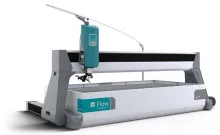Mach 4c XD 3020 Waterjet

Manufacturer: Flow
Quantity: 1
Location:
Main Floor CNC Area
Categories:
Water Jet Cutting
CNC Machining
Temporarily Unavailable
*
*Down for service, contact Adrian Olmeda for status.
Overview
An industrial grade 5-Axis waterjet capable of cutting a variety of materials including: aluminum, steel, glass, granite, foam, rubber and more.
Technical Details
Cutting Pressure: 60,000 PSI
Workspace: 3m x 2m (XY)
Max Workpiece Height: 12"
Linear Straightness Accuracy: +/- 0.001 in/3 ft
Repeatability: +/- 0.001 in
Design for Manufacturability
- A Water Jet will cut pretty much anything you can scratch with a piece of sandpaper. Metal is a common material in the Makerspace, but be aware that the machine can also run on wood, plastic, stone, glass, tile, carbon fiber, and more.
- Ensure raw material is larger than the part by at least 1" on each side, which allows for your raw material to be clamped down to the slats on the machine.
- Cut all edges of your design; do not include any raw material edges in the design as alignment is never perfect. For example, a square should be made of four cut sides, not two cut sides and two raw stock edges.
- Stick with closed paths (shapes). Closed paths are required for the machine to properly compensate for the conical kerf of a water jet stream. Open paths increase setup/programming time and confuse the machine's 5-axis kerf compensation, resulting in angled edges on the part.
- Be prepared to remove tabs on small parts. Tabs are necessary to prevent small parts from falling into the tank and getting lost (annoying) or popping up and breaking the nozzle (expensive). Tabs are about 3mm wide and will be added by the machine operator. They can be removed by filing or sanding.
- Save finishing steps (polishing, etc.) until after your parts are cut. Back-spray from the jet's interaction with table slats will abrade the under-side of the material during cutting. In metal, this looks like a slightly rough area similar to a sand-blasted finish.
- The cutting "tool" (water jet stream) has a diameter of 0.035". This effectively puts a radius of 0.018" on all features. Features in this size range (tiny) will likely be degraded or missing.
- Typical fixturings require material to have sufficient strength and rigidity to remain stationary during cutting. Thin or unstable materials may require sandwiching between additional sheet materials to facilitate cutting, or may be inappropriate for waterjet cutting altogether.
Useful Links
Access & Hazard Information
Staff Use OnlyUse of this equipment is reserved for Makerspace staff members only. If a project of yours requires the use of this equipment, speak with a Makerspace staff member.
Hazard Class 4- Hazards: As above, but potential for serious amputations and life-threatening injuries
- Power: As above, but self-standing and 3 phase power
- Examples: Powder actuated tools, table saws, manual mills and lathes
- Access Requirements: Members must attend a training session and pass written and hands-on exams. Improper use will be punished with a verbal warning, a note in the members file, mandatory retraining, and potiential loss of access to the space..
- Supervision Requirements: The Makerspace must be open and a dedicated staff member must supervise use of this equipment for the entirety of its operation. Staff may deny access or place additional restrictions on use of this equipment on a per-use or per-person basis.